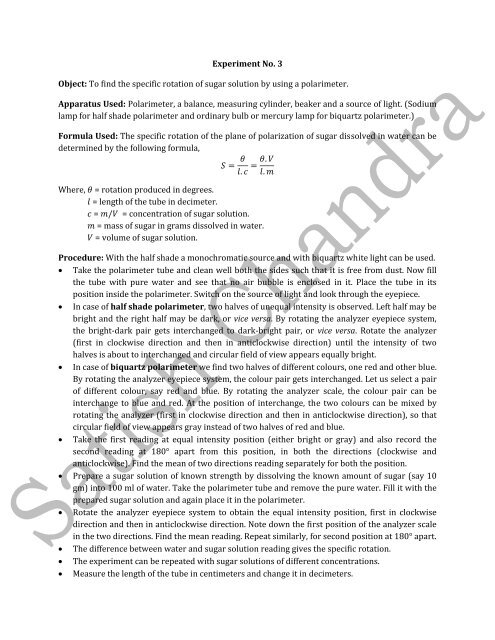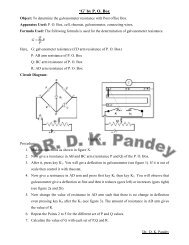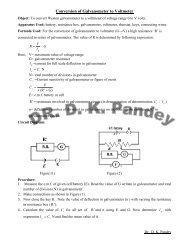To find the specific rotation of sugar solution by using a polarimeter ...
To find the specific rotation of sugar solution by using a polarimeter ...
To find the specific rotation of sugar solution by using a polarimeter ...
- No tags were found...
You also want an ePaper? Increase the reach of your titles
YUMPU automatically turns print PDFs into web optimized ePapers that Google loves.
Experiment No. 3Object: <strong>To</strong> <strong>find</strong> <strong>the</strong> <strong>specific</strong> <strong>rotation</strong> <strong>of</strong> <strong>sugar</strong> <strong>solution</strong> <strong>by</strong> <strong>using</strong> a <strong>polarimeter</strong>.Apparatus Used: Polarimeter, a balance, measuring cylinder, beaker and a source <strong>of</strong> light. (Sodiumlamp for half shade <strong>polarimeter</strong> and ordinary bulb or mercury lamp for biquartz <strong>polarimeter</strong>.)Formula Used: The <strong>specific</strong> <strong>rotation</strong> <strong>of</strong> <strong>the</strong> plane <strong>of</strong> polarization <strong>of</strong> <strong>sugar</strong> dissolved in water can bedetermined <strong>by</strong> <strong>the</strong> following formula, . . . Where, = <strong>rotation</strong> produced in degrees. = length <strong>of</strong> <strong>the</strong> tube in decimeter. = / = concentration <strong>of</strong> <strong>sugar</strong> <strong>solution</strong>. = mass <strong>of</strong> <strong>sugar</strong> in grams dissolved in water. = volume <strong>of</strong> <strong>sugar</strong> <strong>solution</strong>.Procedure: With <strong>the</strong> half shade a monochromatic source and with biquartz white light can be used.• Take <strong>the</strong> <strong>polarimeter</strong> tube and clean well both <strong>the</strong> sides such that it is free from dust. Now fill<strong>the</strong> tube with pure water and see that no air bubble is enclosed in it. Place <strong>the</strong> tube in itsposition inside <strong>the</strong> <strong>polarimeter</strong>. Switch on <strong>the</strong> source <strong>of</strong> light and look through <strong>the</strong> eyepiece.• In case <strong>of</strong> half shade <strong>polarimeter</strong>, two halves <strong>of</strong> unequal intensity is observed. Left half may bebright and <strong>the</strong> right half may be dark, or vice versa. By rotating <strong>the</strong> analyzer eyepiece system,<strong>the</strong> bright‐dark pair gets interchanged to dark‐bright pair, or vice versa. Rotate <strong>the</strong> analyzer(first in clockwise direction and <strong>the</strong>n in anticlockwise direction) until <strong>the</strong> intensity <strong>of</strong> twohalves is about to interchanged and circular field <strong>of</strong> view appears equally bright.• In case <strong>of</strong> biquartz <strong>polarimeter</strong> we <strong>find</strong> two halves <strong>of</strong> different colours, one red and o<strong>the</strong>r blue.By rotating <strong>the</strong> analyzer eyepiece system, <strong>the</strong> colour pair gets interchanged. Let us select a pair<strong>of</strong> different colour, say red and blue. By rotating <strong>the</strong> analyzer scale, <strong>the</strong> colour pair can beinterchange to blue and red. At <strong>the</strong> position <strong>of</strong> interchange, <strong>the</strong> two colours can be mixed <strong>by</strong>rotating <strong>the</strong> analyzer (first in clockwise direction and <strong>the</strong>n in anticlockwise direction), so thatcircular field <strong>of</strong> view appears gray instead <strong>of</strong> two halves <strong>of</strong> red and blue.• Take <strong>the</strong> first reading at equal intensity position (ei<strong>the</strong>r bright or gray) and also record <strong>the</strong>second reading at 180° apart from this position, in both <strong>the</strong> directions (clockwise andanticlockwise). Find <strong>the</strong> mean <strong>of</strong> two directions reading separately for both <strong>the</strong> position.• Prepare a <strong>sugar</strong> <strong>solution</strong> <strong>of</strong> known strength <strong>by</strong> dissolving <strong>the</strong> known amount <strong>of</strong> <strong>sugar</strong> (say 10gm) into 100 ml <strong>of</strong> water. Take <strong>the</strong> <strong>polarimeter</strong> tube and remove <strong>the</strong> pure water. Fill it with <strong>the</strong>prepared <strong>sugar</strong> <strong>solution</strong> and again place it in <strong>the</strong> <strong>polarimeter</strong>.• Rotate <strong>the</strong> analyzer eyepiece system to obtain <strong>the</strong> equal intensity position, first in clockwisedirection and <strong>the</strong>n in anticlockwise direction. Note down <strong>the</strong> first position <strong>of</strong> <strong>the</strong> analyzer scalein <strong>the</strong> two directions. Find <strong>the</strong> mean reading. Repeat similarly, for second position at 180° apart.• The difference between water and <strong>sugar</strong> <strong>solution</strong> reading gives <strong>the</strong> <strong>specific</strong> <strong>rotation</strong>.• The experiment can be repeated with <strong>sugar</strong> <strong>solution</strong>s <strong>of</strong> different concentrations.• Measure <strong>the</strong> length <strong>of</strong> <strong>the</strong> tube in centimeters and change it in decimeters.
Half Shade orBiquartz devicePolarimeter tubeEye pieceLightSourceLensPolarizerFigure1: Arrangement inside <strong>the</strong> <strong>polarimeter</strong>.AnalyzerObservations: Room temperature = ………...°C(A) Preparation <strong>of</strong> <strong>sugar</strong> <strong>solution</strong>:Mass <strong>of</strong> watch glass = ………gm = …… …kgWatch glass + <strong>sugar</strong> = ………gm = …….…kgTherefore mass <strong>of</strong> <strong>sugar</strong> taken, = ……….gm = ………… kgVolume <strong>of</strong> <strong>the</strong> <strong>solution</strong> V = ….….…..ml = ………….c.c.Concentration <strong>of</strong> <strong>the</strong> <strong>solution</strong> = / = …………gm / c.c. = ………...kg/m 3Length <strong>of</strong> <strong>the</strong> <strong>polarimeter</strong> tube = ……….cm = ………….decimeter(B) Tables for <strong>the</strong> determination <strong>of</strong> <strong>specific</strong> <strong>rotation</strong>:Value <strong>of</strong> one division <strong>of</strong> <strong>the</strong> main scale = ………….No. <strong>of</strong> division on vernier scale = ………….Least count <strong>of</strong> vernier = ……………With WaterS.No Analyzer’s reading for I position Analyzer’s reading for II positionClockwise Anticlockwise Mean Clockwise Anticlockwise Mean123MS VS T (a) MS VS T (a’) MS VS T (b) MS VS T (b’) Mean, A Mean, B With Sugar Solution <strong>of</strong> concentration ……………..S.No Analyzer’s reading for I position Analyzer’s reading for II positionClockwise Anticlockwise Mean Clockwise Anticlockwise MeanMS VS T (c) MS VS T (c’) MS VS T (d) MS VS T (d’)123Mean, C MS = Main Scale Reading, VS = Vernier Scale Reading, T = MS+VS = <strong>To</strong>tal Reading.Mean, D
Calculation: According to <strong>the</strong> analyzer’s reading;• For I position, <strong>rotation</strong> produced <strong>by</strong> <strong>sugar</strong> <strong>solution</strong>, • For II position, <strong>rotation</strong> produced <strong>by</strong> <strong>sugar</strong> <strong>solution</strong>, Thus, <strong>the</strong> mean <strong>rotation</strong> produced <strong>by</strong> cane <strong>sugar</strong> <strong>solution</strong>, 2Then, <strong>the</strong> <strong>specific</strong> <strong>rotation</strong> <strong>of</strong> <strong>the</strong> cane <strong>sugar</strong> <strong>solution</strong>, . Result: At a temperature …..…°C and wavelength …..… Å;The <strong>specific</strong> <strong>rotation</strong> for cane <strong>sugar</strong> <strong>solution</strong> = ……….Standard Value <strong>of</strong> <strong>specific</strong> <strong>rotation</strong> for cane <strong>sugar</strong> <strong>solution</strong> = ….……Percentage Error = …..%.Sources <strong>of</strong> error and Precautions:(i) The <strong>polarimeter</strong> tube should be well cleaned.(ii) Water used should be dust free.(iii) Whenever a <strong>solution</strong> is changed, rinse <strong>the</strong> tube with <strong>the</strong> new <strong>solution</strong> under examination.(iv) There should be no air bubble inside <strong>the</strong> tube.(v) The position <strong>of</strong> analyzer should be set accurately.(vi) The temperature and wavelength <strong>of</strong> light used should be stated.(vii) Reading should be taken when halves <strong>of</strong> <strong>the</strong> field <strong>of</strong> view becomes equally illuminated.



![Ã
tkZ % laHkkouk;sa] mi;ksx vkSj laj{k.kA Energy : Explore, Harness ...](https://img.yumpu.com/49782265/1/190x245/atkz-lahkkouksa-miksx-vksj-lajkka-energy-explore-harness-.jpg?quality=85)


